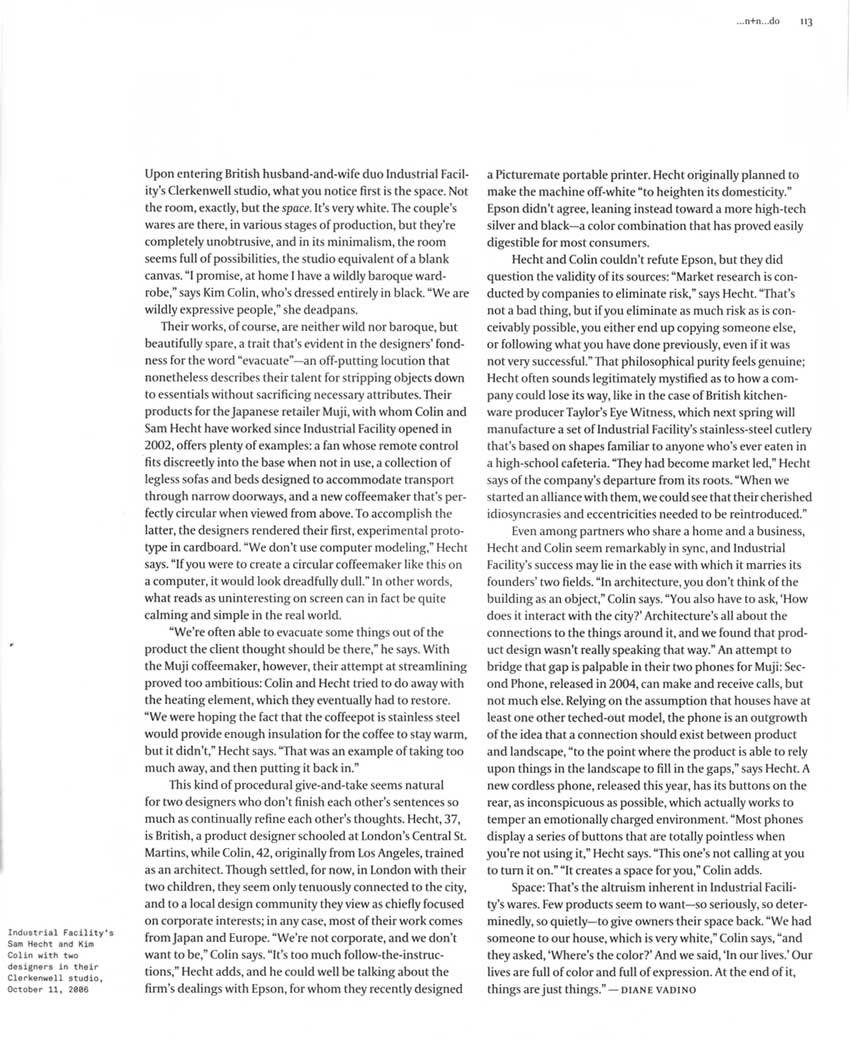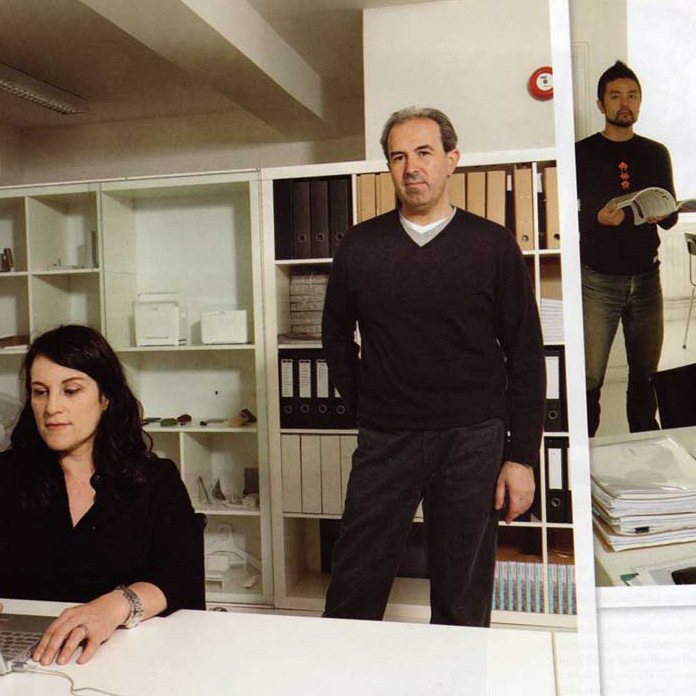

Industrial Facility for ID: Upon entering the Clerkenwell studio of British husband-and-wife duo Industrial Facility , what you notice first is the space. Not the room, exactly, but the space. It’s very white. The couple’s wares are there, in various stages of production, but they’re completely unobtrusive, and in its minimalism, the room seems full of possibilities, the studio equivalent of a blank canvas. “I promise, at home I have a wildly baroque wardrobe,” says Kim Colin, who’s dressed entirely in black. “We are wildly expressive people,” she deadpans.
You might have guessed as much from the designers’ fondness for the word “evacuate,” an off-putting locution that describes the duo’s talent for stripping objects down to essentials without sacrificing necessary attributes—or adding superfluous ones. Their products for the Japanese retailer Muji, with whom Colin and Hecht have worked since Industrial Facility opened in 2002, offers plenty of examples: a fan whose remote control fits discreetly into the base when not in use, a collection of sofas and beds designed to accommodate transport through narrow doorways, and a set of playing cards reduced to their basics: no blond-haired jacks, no well-coiffed queens, just a numeral and a symbol denoting each of the four suits.
“We’re often able to evacuate some things out of the product the client thought should be there,” says Hecht. (There’s that word again.) Consider their new coffeemaker, also for Muji: Hecht wanted the machine to be circular when viewed from above, so the designers rendered their first, experimental prototype in cardboard. “We don’t use computer modeling,” Hecht says. “If you were to create a circular coffeemaker like this on a computer, it would look dreadfully dull.” In other words, what reads as uninteresting on screen can in fact be quite calming and simple in the real world—a nuance that Hecht and Colin were, and are, eager to explore. Unfortunately, their coffeepot evacuation wasn’t limited to profile: Colin and Hecht originally did away with the heating element, which was eventually restored. “We were hoping the fact that the coffee pot is stainless steel would provide enough insulation for the coffee to stay warm, but it didn’t,” Hecht says. “That was an example of taking too much away, and then putting it back in.”
This kind of procedural give-and-take seems natural for two designers who don’t finish each other’s sentences so much as continually refine each other’s thoughts. London-born Hecht, 37, is British, a product designer schooled at London’s Central St. Martins, while Colin, originally from Los Angeles, trained as an architect. Though settled, for now, in London with their two children, they seem tenuously connected to the city, and to a local design community they view as chiefly focused on corporate interests; in any case, most of their work comes from Japan and Europe. “Industrial Facility is not corporate, and we don’t want to be,” Colin says. “It’s too much follow-the-instructions,” Hecht adds, and he could well be talking about the firm’s dealings with Epson, for whom they recently designed a Picturemate portable printer. Hecht originally planned to make the machine off-white “to heighten its domesticity.” Epson didn’t agree, leaning instead toward a more high-tech silver and black—a color combination that has proved easily digestible for most consumers.
Hecht and Colin couldn’t refute Epson, but they did question the validity of its sources: “Market research is conducted by companies to essentially eliminate risk,” says Hecht. “That’s not a bad thing, but if you eliminate as much risk as is conceivably possible, you either end up copying someone else, or following what you have done previously, even if it was not very successful.” That philosophical purity feels genuine; Hecht often sounds legitimately mystified as to how a company could lose its way, like in the case of British kitchenware company Taylor’s Eye Witness, which next spring will manufacture a set of stainless-steel cutlery that’s based on shapes familiar to anyone who’s ever eaten in a high-school cafeteria. “They had become market led,” Hecht says of the company’s departure from its roots. “When we started an alliance with them, we could see that their cherished idiosyncrasies and eccentricities needed to be reintroduced.” A perfect fit, then, for an elegant set of cutlery with down-market origins. “Kim and I feel strongly that low cost doesn’t have to mean the avoidance of good design,” Hecht says.
Even among partners who share a home and a business, Hecht and Colin seem remarkably in sync, and Industrial Facility’s success may be in the way it marries its founders’ two fields—the way their products relate directly to their environments. “In architecture, you don’t think of the building as an object,” Colin says. “You also have to ask, ‘How does it interact with the city?’ Architecture’s all about the connections to the things around it, and we found that product design wasn’t really speaking that way.” An attempt to bridge that gap is palpable in their two phones for Muji: Second Phone can make and receive calls, but not much else. Relying on the assumption that houses have at least one other teched-out model, the phone is an outgrowth of the idea that a connection should exist between product and landscape, “to the point where the product is able to rely upon things in the landscape to fill in the gaps,” says Hecht. A new cordless phone, released this year, has its buttons on the rear, as inconspicuous as possible, which actually works to temper an emotionally charged environment. “Most phones present a product with a series of buttons on display that are totally pointless when you’re not using it,” Hecht says. “This one’s not calling at you to turn it on.” “It creates a space for you,” Colin adds.
Space: That’s the altruism inherent in Industrial Facility’s wares. Few products seem to want—so seriously, so determinedly, so quietly—to give owners their space back. “We had someone to our house, which is very white,” Colin says, “and they asked, ‘Where’s the color?’ And we said, ‘In our lives.’ Our lives are full of color and full of expression. At the end of it, things are just things.”
